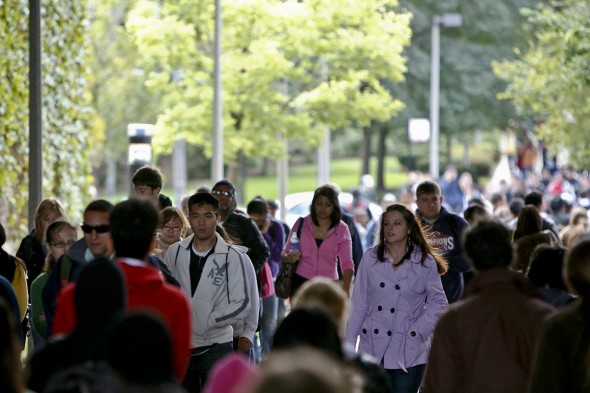Rate-of-inflation tuition increase as state payments to university lag

Tuition rates for entering fall 2013 in-state freshmen will increase 1.7 percent, comparable to the rate of inflation. Photo: Joshua Clark/UIC Photo Services
The university approved a 1.7 percent tuition increase for entering fall 2013 in-state freshmen — the smallest increase for UI tuition since 1994 — at Thursday’s meeting of the Board of Trustees in Chicago.
The board also learned that, as of that day, the state owed the university $502 million in funding budgeted for operating costs this year.
The backlog in payments is “the worst we’ve ever had,” said Walter Knorr, the university’s chief financial officer.
The tuition increase, passed at the board meeting in Student Center West, matches the current rate of inflation.
“This modest increase will help us be competitive in student recruitment,” said Christophe Pierre, university vice president for academic affairs. “It also allows for necessary investment in essential academic quality.”
The relatively small increase means the university must closely contain costs, but it will sustain financial aid programs, Pierre said.
The guaranteed four-year tuition is the equivalent of 0.7 percent per year during the four years that rates are locked in under the state’s guaranteed tuition law. The tuition guarantee, a state law that took effect in 2004, sets tuition rates for public universities for the four years required to complete most undergraduate degree programs.
The recommended increase follows a policy passed by the board two years ago that aims to hold down costs by limiting increases to an index of the cost of living, barring significant reductions in state funding or other university support.
Tuition rates set for incoming in-state freshmen next fall are:
• UIC: a $174 increase, to $10,406 per academic year
• Urbana-Champaign: a $198 increase to $11,834 per academic year
• UIS: a $158 increase, to $9,248.
In dollars, the increase would be the smallest since the 2000-01 academic year in Urbana-Champaign and Chicago, and the smallest since 2001-02 in Springfield.
Last year’s increase for incoming, in-state students was an average 4.8 percent. Tuition rose 6.9 percent for 2011-12 and 9.5 percent for 2010-11 to help offset steep declines in state funding.
The university’s annual state appropriation, which covers day-to-day operating costs, has decreased nearly 23 percent – or about $180 million – since fiscal 2002.
Pierre said that although the university hopes to hold future tuition increases to the rate of inflation or below, significant reductions in state funding could lead to larger increases.
The board decided last year to set tuition rates for the upcoming year in January, to make the planning process easier for families and allow more time to arrange financial aid.
Undergraduate Fees / Housing
The board also passed increases in room-and-board rates and student fees for the next academic year.
Housing costs for next year will be:
• UIC: double-occupancy room and 14-meal plan will increase 2 percent, or $201, to $10,261 per year.
• Urbana-Champaign: undergraduate room-and-board costs, based on the standard double-occupancy room and 14-meal-per-week plan, will rise 3 percent, or $291, to $9,979 per year. Room-and-board costs are locked in for up to four years if students continue to live in campus residence halls.
• UIS: the cost for a double-occupancy room in Lincoln Residence Hall with a full meal plan will rise 4.9 percent, or $480, to $10,350 per year.
Student fee increases (not including student health insurance rates, which are usually set in March) will be:
• UIC: 1.5 percent, or $44, to $2,948 per year
• Urbana campus: 1 percent, or $30, to $2,916 per year
• UIS: 6.1 percent, or $110, to $1,892 per year, due largely to a student-authorized increase in a library technology fee.
Complete information on undergraduate and graduate tuition for next year is online.
